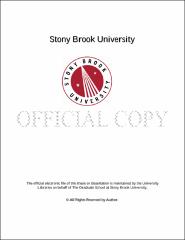| dc.identifier.uri | http://hdl.handle.net/11401/77025 | |
| dc.description.sponsorship | This work is sponsored by the Stony Brook University Graduate School in compliance with the requirements for completion of degree. | en_US |
| dc.format | Monograph | |
| dc.format.medium | Electronic Resource | en_US |
| dc.language.iso | en_US | |
| dc.publisher | The Graduate School, Stony Brook University: Stony Brook, NY. | |
| dc.type | Dissertation | |
| dcterms.abstract | In 2014, an estimated 480,000 people developed MDR-TB and 190,000 people died as a result of it. Approximately 9.7 % of people with MDR-TB are estimated to have XDR-TB. With the increase in the number of MDR-TB and XDR-TB cases, there is a dire need for the development of new anti-TB agents with novel mechanism of action. FtsZ, a crucial bacterial cytokinesis protein is a potential target for the development of new anti-TB agents. Previously a library of 2,5,6- and 2,5,7-trisubstituted benzimidazoles were synthesized and tested for their anti-TB activity. The lead molecules inhibited the assembly of Mycobacterium tuberculosis FtsZ by enhancing the GTPase activity. Based on the SAR studies, a new series of 2,5,6-trisubstituted benzimidazole library containing a dimethylamino group at the 6-position and various modifications at the 2-position was designed and synthesized. Trisubstituted indole analogs of the lead benzimidazoles were also synthesized as a part of SAR studies. Fungal infections affect an estimated 300 million people globally. With existing drugs displaying drawbacks like drug-drug interactions, toxicity and narrow spectrum of activity and emergence of fungal infections resistant to current drugs, new antifungal agents with novel targets are crucial. In this context, fungal sphingolopids is a promising target as it is essential for their virulence in alkaline environment. Screening of a library of 49,120 compounds from ChemBridge against C. neoformans, led to the identification of two hits, BHBM and D0 with MFC of 4 μg/mL and 1.2 μg/mL respectively. Further screening found three more hit compounds, which exhibited potent antifungal activity (MIC80 0.03 μg/mL). Based on these results, a new library of aromatic acylhydrazides has been designed and synthesized for SAR studies. Synthesis, biological activity, and SAR study of the new library of anti-fungal acylhydrazones will be presented. | |
| dcterms.abstract | In 2014, an estimated 480,000 people developed MDR-TB and 190,000 people died as a result of it. Approximately 9.7 % of people with MDR-TB are estimated to have XDR-TB. With the increase in the number of MDR-TB and XDR-TB cases, there is a dire need for the development of new anti-TB agents with novel mechanism of action. FtsZ, a crucial bacterial cytokinesis protein is a potential target for the development of new anti-TB agents. Previously a library of 2,5,6- and 2,5,7-trisubstituted benzimidazoles were synthesized and tested for their anti-TB activity. The lead molecules inhibited the assembly of Mycobacterium tuberculosis FtsZ by enhancing the GTPase activity. Based on the SAR studies, a new series of 2,5,6-trisubstituted benzimidazole library containing a dimethylamino group at the 6-position and various modifications at the 2-position was designed and synthesized. Trisubstituted indole analogs of the lead benzimidazoles were also synthesized as a part of SAR studies. Fungal infections affect an estimated 300 million people globally. With existing drugs displaying drawbacks like drug-drug interactions, toxicity and narrow spectrum of activity and emergence of fungal infections resistant to current drugs, new antifungal agents with novel targets are crucial. In this context, fungal sphingolopids is a promising target as it is essential for their virulence in alkaline environment. Screening of a library of 49,120 compounds from ChemBridge against C. neoformans, led to the identification of two hits, BHBM and D0 with MFC of 4 μg/mL and 1.2 μg/mL respectively. Further screening found three more hit compounds, which exhibited potent antifungal activity (MIC80 0.03 μg/mL). Based on these results, a new library of aromatic acylhydrazides has been designed and synthesized for SAR studies. Synthesis, biological activity, and SAR study of the new library of anti-fungal acylhydrazones will be presented. | |
| dcterms.available | 2017-09-20T16:51:41Z | |
| dcterms.contributor | Tonge, Peter J | en_US |
| dcterms.contributor | Ojima, Iwao | en_US |
| dcterms.contributor | Drueckhammer, Dale G | en_US |
| dcterms.contributor | Del Poeta, Maurizio. | en_US |
| dcterms.creator | Haranahalli Raghunandan, Krupanandan | |
| dcterms.dateAccepted | 2017-09-20T16:51:41Z | |
| dcterms.dateSubmitted | 2017-09-20T16:51:41Z | |
| dcterms.description | Department of Chemistry | en_US |
| dcterms.extent | 261 pg. | en_US |
| dcterms.format | Monograph | |
| dcterms.format | Application/PDF | en_US |
| dcterms.identifier | http://hdl.handle.net/11401/77025 | |
| dcterms.issued | 2016-12-01 | |
| dcterms.language | en_US | |
| dcterms.provenance | Made available in DSpace on 2017-09-20T16:51:41Z (GMT). No. of bitstreams: 1
HaranahalliRaghunandan_grad.sunysb_0771E_13021.pdf: 16567702 bytes, checksum: 554884ef564dbb97e11a3ad3fbb70505 (MD5)
Previous issue date: 1 | en |
| dcterms.publisher | The Graduate School, Stony Brook University: Stony Brook, NY. | |
| dcterms.subject | Chemistry | |
| dcterms.title | Development of novel antimicrobial agents through inhibition of cytokinetic protein FtsZ in Mycobacterium tuberculosis and sphingolipid GlcCer in fungi | |
| dcterms.type | Dissertation | |

